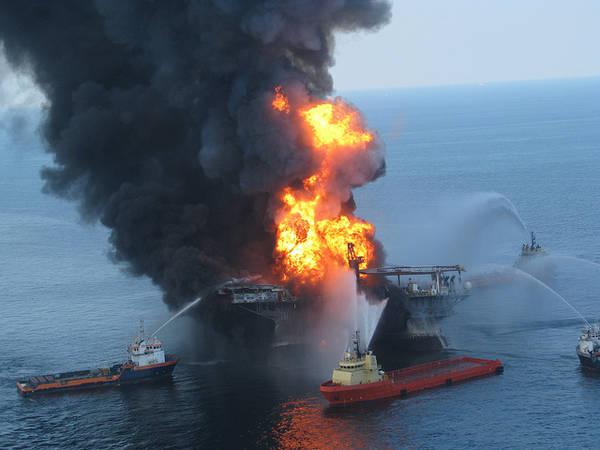Corporate Corruption

The full statement from the Department of Justice is below.
Halliburton Agrees to Plead Guilty to Destruction of Evidence in Connection with Deepwater Horizon Tragedy Third Corporate Guilty Plea Obtained by the Deepwater Horizon Task Force
Halliburton Energy Services Inc. has agreed to plead guilty to destroying evidence in connection with the Deepwater Horizon disaster, the Department of Justice announced today. A criminal information charging Halliburton with one count of destruction of evidence was filed today in U.S. District Court in the Eastern District of Louisiana.Related news, none of which is likely to be particularly good for Halliburton shareholders: Halliburton is one of multiple companies named in a US Department of Justice fracking antitrust probe.
Halliburton has signed a cooperation and guilty plea agreement with the government in which Halliburton has agreed to plead guilty and admit its criminal conduct. As part of the plea agreement, Halliburton has further agreed, subject to the court’s approval, to pay the maximum-available statutory fine, to be subject to three years of probation and to continue its cooperation in the government’s ongoing criminal investigation. Separately, Halliburton made a voluntary contribution of $55 million to the National Fish and Wildlife Foundation that was not conditioned on the court’s acceptance of its plea agreement.
According to court documents, on April 20, 2010, while stationed at the Macondo well site in the Gulf of Mexico, the Deepwater Horizon rig experienced an uncontrolled blowout and related explosions and fire, which resulted in the deaths of 11 rig workers and the largest oil spill in U.S. history. Following the blowout, Halliburton conducted its own review of various technical aspects of the well’s design and construction. On or about May 3, 2010, Halliburton established an internal working group to examine the Macondo well blowout, including whether the number of centralizers used on the final production casing could have contributed to the blowout. A production casing is a long, heavy metal pipe set across the area of the oil and natural gas reservoir. Centralizers are protruding metal collars affixed at various intervals on the outside of the casing. Use of centralizers can help keep the casing centered in the wellbore away from the surrounding walls as it is lowered and placed in the well. Centralization can be significant to the quality of subsequent cementing around the bottom of the casing. Prior to the blowout, Halliburton had recommended to BP the use of 21 centralizers in the Macondo well. BP opted to use six centralizers instead.
As detailed in the information, in connection with its own internal post-incident examination of the well, in or about May 2010, Halliburton, through its Cementing Technology Director, directed a Senior Program Manager for the Cement Product Line (Program Manager) to run two computer simulations of the Macondo well final cementing job using Halliburton’s Displace 3D simulation program to compare the impact of using six versus 21 centralizers. Displace 3D was a next-generation simulation program that was being developed to model fluid interfaces and their movement through the wellbore and annulus of a well. These simulations indicated that there was little difference between using six and 21 centralizers. Program Manager was directed to, and did, destroy these results.
In or about June 2010, similar evidence was also destroyed in a later incident. Halliburton’s Cementing Technology Director asked another, more experienced, employee (“Employee 1”) to run simulations again comparing six versus 21 centralizers. Employee 1 reached the same conclusion and, like Program Manager before him, was then directed to “get rid of” the simulations.
Efforts to forensically recover the original destroyed Displace 3D computer simulations during ensuing civil litigation and federal criminal investigation by the Deepwater Horizon Task Force were unsuccessful.
In agreeing to plead guilty, Halliburton has accepted criminal responsibility for destroying the aforementioned evidence.
The guilty plea agreement and criminal charge announced today are part of the ongoing criminal investigation by the Deepwater Horizon Task Force into matters related to the April 2010 Gulf oil spill. The Deepwater Horizon Task Force, based in New Orleans, is supervised by Acting Assistant Attorney General Mythili Raman and led by John D. Buretta, who serves as the director of the task force. The task force includes prosecutors from the Criminal Division and the Environment and Natural Resources Division of the Department of Justice; the U.S. Attorney’s Office for the Eastern District of Louisiana and other U.S. Attorney’s Offices; and investigating agents from: the FBI; Department of the Interior, Office of Inspector General; Environmental Protection Agency, Criminal Investigation Division; Environmental Protection Agency, Office of Inspector General; National Oceanic and Atmospheric Administration, Office of Law Enforcement; U.S. Coast Guard; U.S. Fish and Wildlife Service; and the Louisiana Department of Environmental Quality.
The case is being prosecuted by Deepwater Horizon Task Force Director John D. Buretta, Deputy Directors Derek A. Cohen and Avi Gesser, and task force prosecutors Richard R. Pickens II, Scott M. Cullen, Colin Black and Rohan Virginkar.
An information is merely a charge and a defendant is presumed innocent unless and until proven guilty beyond a reasonable doubt.
And defense contractor KBR, a former Halliburton subsidiary previously known as Kellogg Brown & Root, must face claims that its employees took kickbacks while shipping military equipment to Iraq and Afghanistan, according to a ruling by the US 5th Circuit.

No comments:
Post a Comment